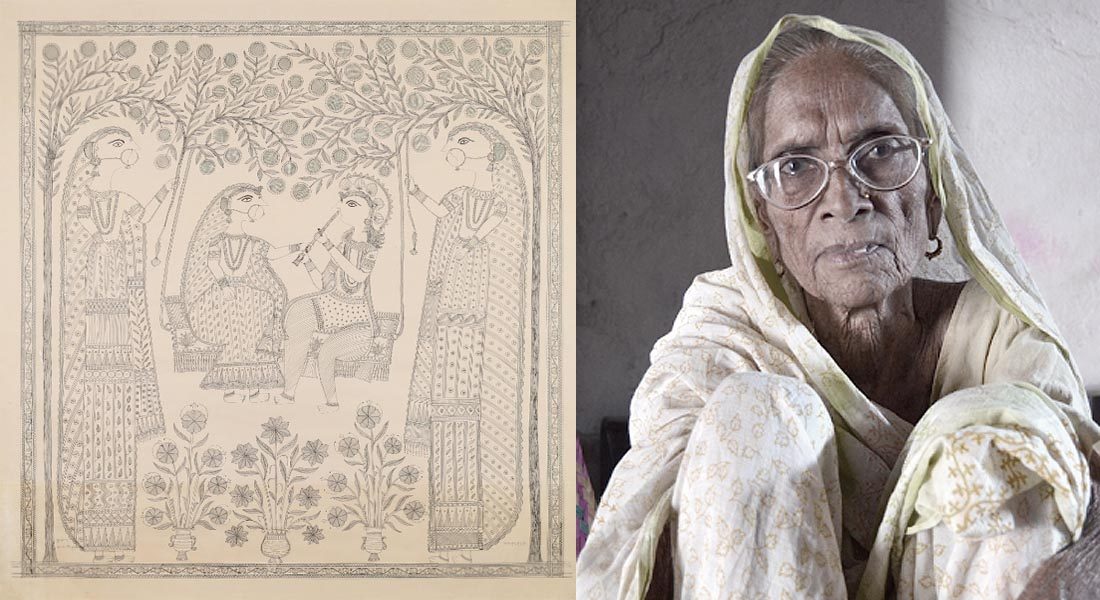पद्मश्री महासुंदरी देवी का जन्म 16 अप्रैल 1922 को मधुबनी जिला के चतरा गांव में हुआ था। महज पांच वर्ष की उम्र में ही उनके पिता रामजीवन लाभ और मां दुलारी देवी का निधन हो गया। चाचा पुनीत लाभ और चाची देवसुंदरी देवी ने उनका लालन-पालन किया। अपने चाचा और चाची के सानिध्य में ही नन्ही महासुंदरी ने प्राथमिक शिक्षा पायी और पारंपरिक मिथिला कला भी सीखी। उनका विवाह रांटी गांव के कृष्ण कुमार दास से हुए जिन्होंने उनकी कला को खूब प्रोत्साहित किया।
1962 में अखिल भारतीय हस्तशिल्प बोर्ड के कला पारखी एवं अन्वेषक भाष्कर कुलकर्णी ने व्यावसायिक रूप से चित्र बनाने के लिए जिन पांच महिला कलाकारों का चयन किया था, उनमें महासुंदरी देवी भी शामिल थीं। मुख्य रूप से कचनी शैली में मिथिला चित्र लिखने के लिए ख्यातिलब्ध महासुंदरी देवी धागे को काले रंग में भिंगोकर कागज पर रेखांकन करती थीं और रंगीन रेखाओं के साथ उन्हें संयोजित कर कलाकृतियां लिखा करती थीं। अपने चित्रों में उन्होंने सपाट रंगों का प्रयोग नहीं के बराबर किया।
महासुंदरी देवी कोहबर लेखन में निपुण थीं। कोहबर के अलावा उन्होंने जिन विषयों पर चित्र बनाएं उनमें धार्मिक कथानक, पुराख्यान, रीति-रिवाज, पर्व-त्योहार आदि शामिल हैं। उनके दृश्यों को उन्होंने अत्यंत सधाई से कागज पर उकेरा। चित्र बनाने के लिए वह प्राकृतिक रंगों का प्रयोग करती थीं। मिथिला चित्रकला में एक्रेलिक रंगों का पहला प्रयोग महासुंदरी देवी ने ही किया। उन्हें इस बात का भी श्रेय दिया जाता है कि उन्होंने 1974 में साड़ियों एवं अन्य कपड़ों पर मिथिला चित्र बनाए। यह अपने आप में एक नया प्रयोग था, जो काफी सफल रहा।
महासुंदरी देवी ने मधुबनी रेलवे स्टेशन और जयंती जनता एक्सप्रेस पर भी चित्रांकन किया। इनके अलावा पटना के होटल पाटलिपुत्र अशोक के लिए उन्होंने सनमाइका पर पचास से ज्यादा चित्र बनाएं। उन्होंने राज्य सभा परिसर के लिए मिथिला चित्रों की एक श्रृंखला बनायी थी जो करीब 66 फीट लंबी थी।
महासुंदरी देवी को अनेक कलाओं में महारत हासिल थी, जिनमें सुजनी और सिक्की कला भी शामिल हैं। सुजनी की ख्यातिलब्ध कलाकार स्वर्गीय कर्पूरी देवी ने महासुंदरी देवी से ही सुजनी की कला सीखी थी, जिसके लिए उन्हें बाद में नेशनल मेरिट सम्मान से नवाजा गया।
मिथिला चित्रकला में महासुंदरी देवी के योगदान के लिए सरकार ने 2011 में उन्हें पद्म पुरस्कार से अलंकृत किया। इससे पूर्व उन्हें 1982 में राष्ट्रीय पुरस्कार, 1997 में मध्य प्रदेश के प्रतिष्ठित तुलसी सम्मान, 2007 में बिहार सरकार के कला विभूति सम्मान और 2008 में भारत सरकार के शिल्प गुरु सम्मान से सम्मानित किया गया था।
महासुंदरी देवी के मार्गदर्शन में अनेक ग्रामीण महिलाओं ने चित्रांकन सीखा। इसके लिए उन्होंने मिथिला हस्तशिल्प कलाकार औद्योगिक सहयोग समिति नामक एक सहकारी समिति भी बनायी थी। उस समिति ने ग्रामीण महिलाओं के समक्ष आर्थिक विकास के नये अवसर उपलब्ध कराए, अनेक महिला कलाकार स्वावलंबी बनीं। यह उनकी सर्वाधिक महत्वपूर्ण उपलब्दि कही जा सकती है।
–
Disclaimer:
The opinions expressed within this article or in any link are the personal opinions of the author. The facts and opinions appearing in the article do not reflect the views of Folkartopedia and Folkartopedia does not assume any responsibility or liability for the same.
Folkartopedia welcomes your support, suggestions and feedback.
If you find any factual mistake, please report to us with a genuine correction. Thank you.
–
Tags: Mahasundari Devi mithila painting, Padma Shri, Padma Shri Mahasundari Devi

